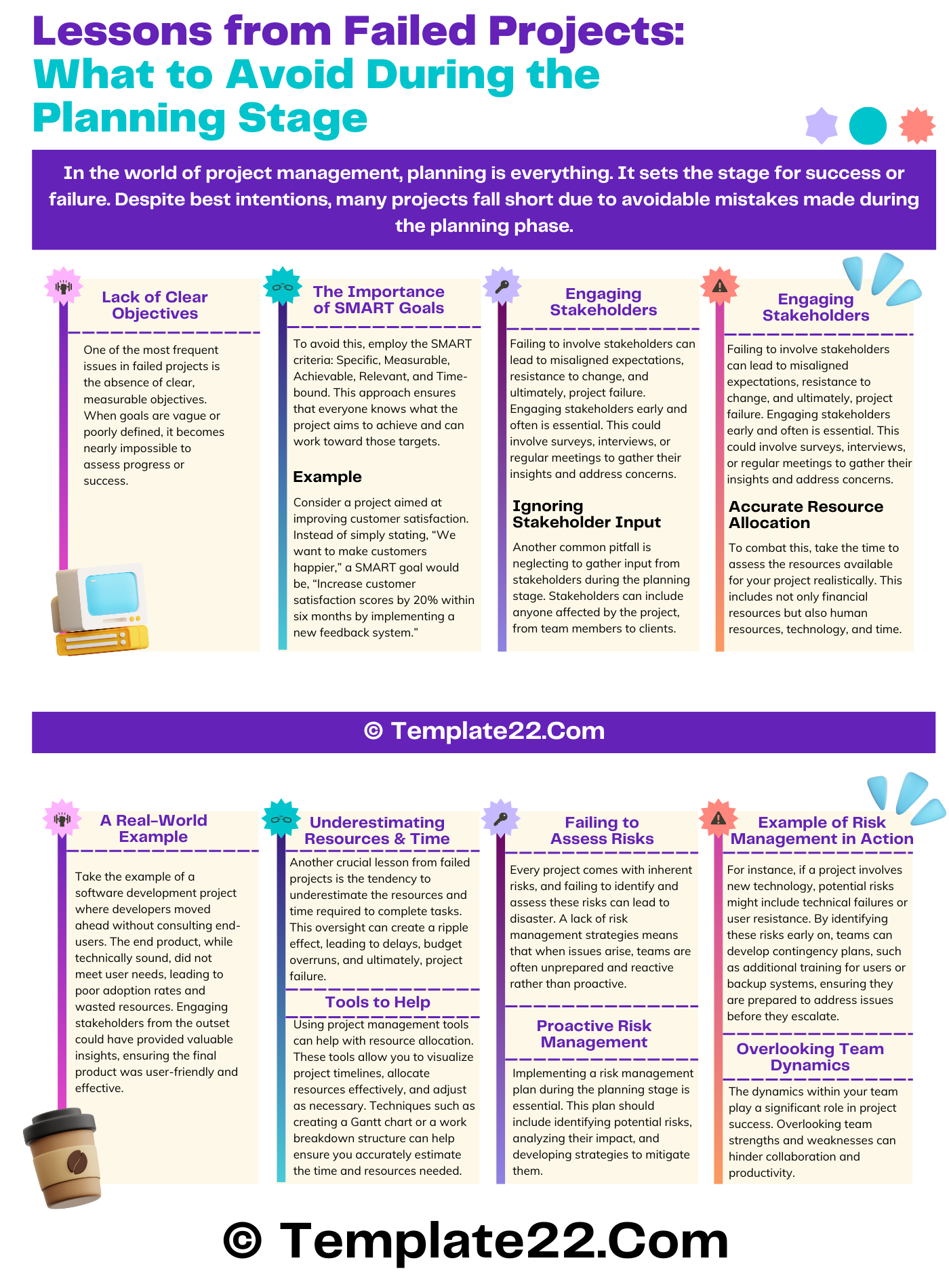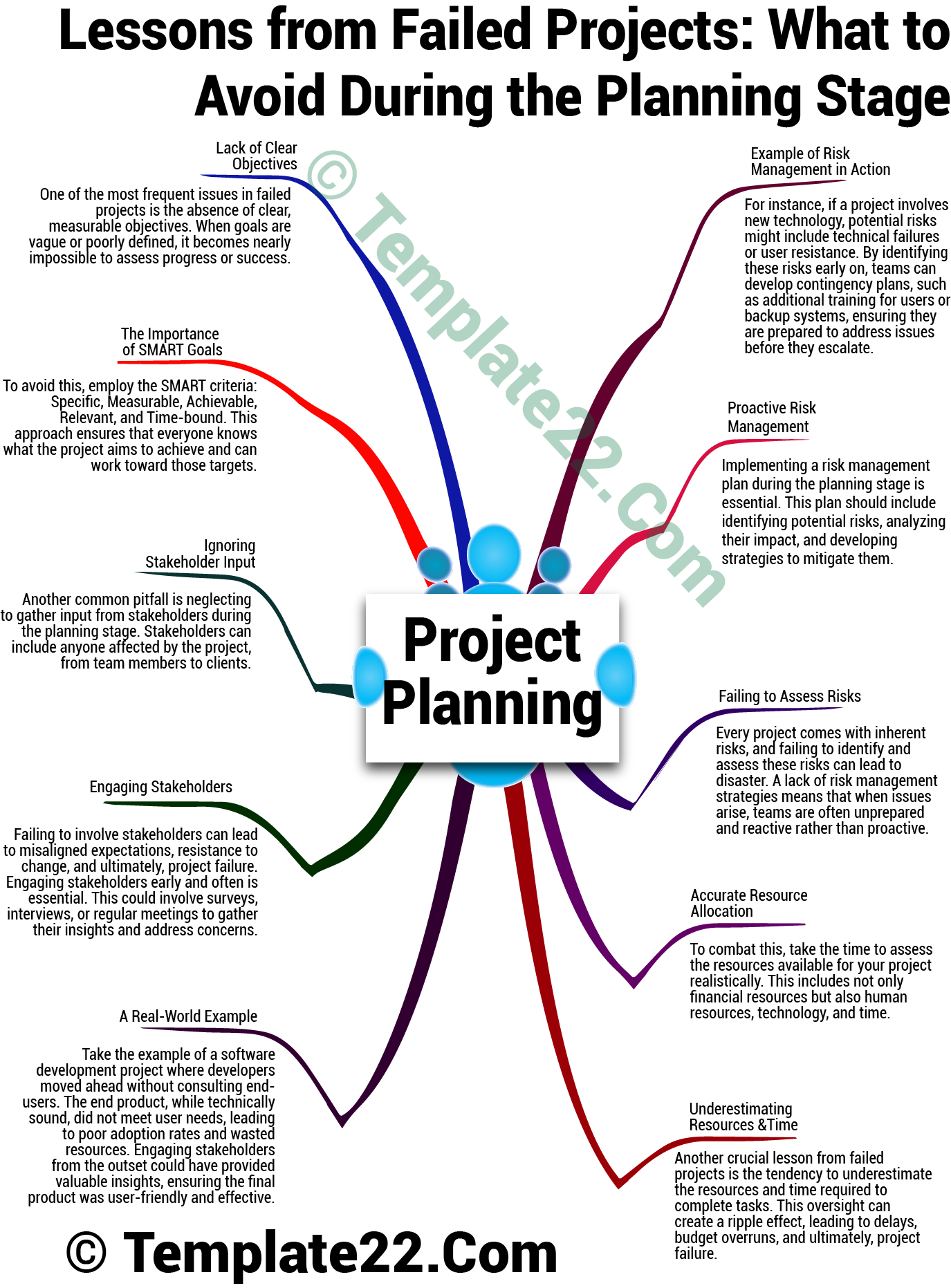 In the world of project management, planning is everything. It sets the stage for success or failure. Despite best intentions, many projects fall short due to avoidable mistakes made during the planning phase. Learning from these failures can help you avoid common pitfalls and set your project on the right path. Let’s dive into some crucial lessons from failed projects and what you should avoid during the planning stage.
In the world of project management, planning is everything. It sets the stage for success or failure. Despite best intentions, many projects fall short due to avoidable mistakes made during the planning phase. Learning from these failures can help you avoid common pitfalls and set your project on the right path. Let’s dive into some crucial lessons from failed projects and what you should avoid during the planning stage.
Lack of Clear Objectives
One of the most frequent issues in failed projects is the absence of clear, measurable objectives. When goals are vague or poorly defined, it becomes nearly impossible to assess progress or success.
The Importance of SMART Goals
To avoid this, employ the SMART criteria: Specific, Measurable, Achievable, Relevant, and Time-bound. This approach ensures that everyone knows what the project aims to achieve and can work toward those targets.
Example
Consider a project aimed at improving customer satisfaction. Instead of simply stating, “We want to make customers happier,” a SMART goal would be, “Increase customer satisfaction scores by 20% within six months by implementing a new feedback system.” This clarity helps everyone understand their role and fosters accountability.
Ignoring Stakeholder Input
Another common pitfall is neglecting to gather input from stakeholders during the planning stage. Stakeholders can include anyone affected by the project, from team members to clients.
CLICK HERE TO DOWNLOAD 300+ PROJECT MANAGEMENT TEMPLATES & DOCUMENTS IN EXCEL
Engaging Stakeholders
Failing to involve stakeholders can lead to misaligned expectations, resistance to change, and ultimately, project failure. Engaging stakeholders early and often is essential. This could involve surveys, interviews, or regular meetings to gather their insights and address concerns.
A Real-World Example
Take the example of a software development project where developers moved ahead without consulting end-users. The end product, while technically sound, did not meet user needs, leading to poor adoption rates and wasted resources. Engaging stakeholders from the outset could have provided valuable insights, ensuring the final product was user-friendly and effective.
Underestimating Resources and Time
Another crucial lesson from failed projects is the tendency to underestimate the resources and time required to complete tasks. This oversight can create a ripple effect, leading to delays, budget overruns, and ultimately, project failure.
Accurate Resource Allocation
To combat this, take the time to assess the resources available for your project realistically. This includes not only financial resources but also human resources, technology, and time.
Tools to Help
Using project management tools can help with resource allocation. These tools allow you to visualize project timelines, allocate resources effectively, and adjust as necessary. Techniques such as creating a Gantt chart or a work breakdown structure can help ensure you accurately estimate the time and resources needed.
Failing to Assess Risks
Every project comes with inherent risks, and failing to identify and assess these risks can lead to disaster. A lack of risk management strategies means that when issues arise, teams are often unprepared and reactive rather than proactive.
Proactive Risk Management
Implementing a risk management plan during the planning stage is essential. This plan should include identifying potential risks, analyzing their impact, and developing strategies to mitigate them.
Example of Risk Management in Action
For instance, if a project involves new technology, potential risks might include technical failures or user resistance. By identifying these risks early on, teams can develop contingency plans, such as additional training for users or backup systems, ensuring they are prepared to address issues before they escalate.
Overlooking Team Dynamics
The dynamics within your team play a significant role in project success. Overlooking team strengths and weaknesses can hinder collaboration and productivity.
Building a Cohesive Team
When planning your project, take the time to understand your team’s dynamics. Consider personality types, communication styles, and working preferences. Fostering an environment where team members feel valued and heard can lead to improved collaboration.
CLICK HERE TO DOWNLOAD 300+ PROJECT MANAGEMENT TEMPLATES & DOCUMENTS IN EXCEL
Tips for Team Building
Activities such as team-building exercises or regular check-ins can help enhance team cohesion. When team members feel connected, they are more likely to communicate effectively and contribute positively to the project.
Conclusion: Learning from the Past
In summary, the planning stage is critical to project success. By learning from failed projects and avoiding common pitfalls—such as lacking clear objectives, ignoring stakeholder input, underestimating resources and time, failing to assess risks, and overlooking team dynamics—you can set your project up for success.
Remember, every project is a learning opportunity. By being mindful of these lessons, you can enhance your planning process, minimize risks, and ultimately achieve better outcomes. So, take a moment to reflect on past projects and consider how you can apply these lessons to your future endeavors. Happy planning!
